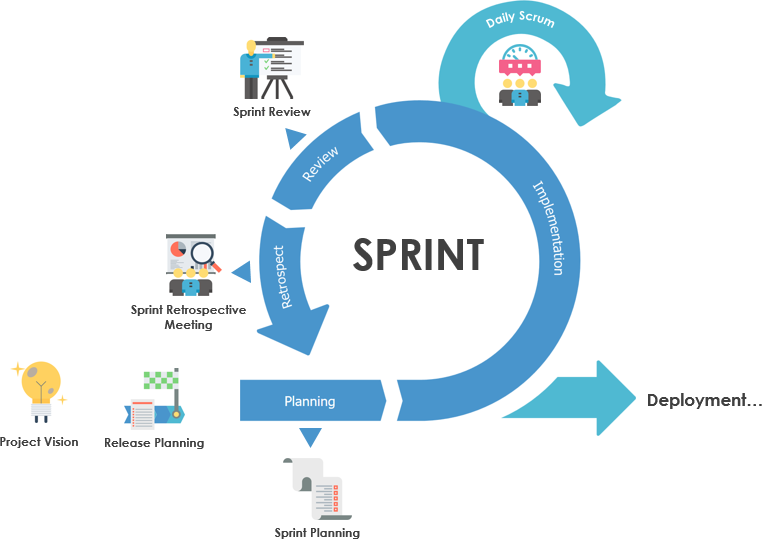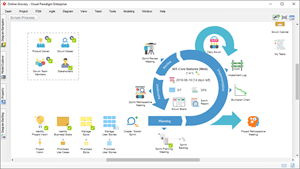Extreme Programming (XP) is an agile software development framework that aims to produce higher quality software, and higher quality of life for the development team. XP is the most specific of the agile frameworks regarding appropriate engineering practices for software development.
Scrum is a framework within which people can address complex adaptive problems, while productively and creatively delivering products of the highest possible value. Scrum itself is a simple framework for effective team collaboration on complex products.
Scrum and XP are both Agile approaches that share the common concepts of iterative development, working software, release and iteration planning, daily meetings, retrospective, all elements of an Agile process. Both approach are aligned each other that sometimes is difficult to distinguish between a team who is adopting XP while another team who is doing Scrum.



Best Scrum Software Every Project Needs
A powerful scrum software that supports scrum project management. It features scrum tools like user story map, product backlog management, sprint backlog management, task management, daily scrum meeting, sprint planning tool, sprint review tool, sprint retrospective tool, burndown, impediment, stakeholder and team management.
There are however some differences, some of them very subtle, and particularly in the following 4 aspects:
1. Iteration length
Scrum
XP
2. Whether requirements are allowed to be modified in an iteration
Scrum
XP
3. Whether User Story is implemented strictly according to priority in iterations.
XP
Scrum
4. Whether to adopt strict engineering methods to ensure progress or quality in the process of software implementation
Scrum
XP
We can summarize the differences between XP and Scrum as follows:
| Aspects | Practices | XP | Scrum |
| Iteration Length | Whether to allow modification of requirements | 1-2 weeks | 2-4 weeks |
| Handle Changes with an Iteration | Whether the demand is strictly in accordance with the priority | It can be replaced with other requirements when a need is not implemented, but the implementation time is equal. | Scrum is not allowed to do this. Once the iteration is completed, no changes are allowed, and Scrum Master is strictly checked. |
| Priority of Features | Whether the demand is strictly in accordance with the priority | Yes | No need to
|
| Engineering Practices | Whether to adopt strict engineering methods to ensure progress or quality | Very strict | Require developers to be conscious |
Therefore, we believes that XP’s approach is acceptable, but it brings Agile into a confusing paradox, because the idea of XP, combined with agile mode, conveys to the team the message that “you are a fully self-managed organization, but you have to implement TDD, pair programming, etc.”
It is not difficult to find that the four distinctions are quite obvious:
Scrum is a framework for product development, which is a container where you can add other practices. XP is one of those practices that you can do within Scrum framework. There are no reasons why a team should choose between Scrum and XP. XP rules and practices are not easy and the majority of XP rules are non-negotiable. Adding XP into Scrum could be a natural path for teams starting out with Scrum and striving to be a professional Scrum Team.
| About Visual Paradigm |
 Visual Paradigm help organizations stay competitive and responsive to change faster and better in today’s fast changing environment. Our award-winning products are trusted by over 320,000 users in companies ranging from small business, consultants, to blue chip organizations, universities and government units across the globe. It enables organizations to improve business and IT agility and foster innovation through popular open standards and process frameworks.Visual Paradigm, a killer Agile feature in 2018, introduced Scrum Process Canvas for automating the way a Scrum team to create, manage and deploy software application that empowers the team to continuously improve their performance at unprecedented speed and scale. Visual Paradigm help organizations stay competitive and responsive to change faster and better in today’s fast changing environment. Our award-winning products are trusted by over 320,000 users in companies ranging from small business, consultants, to blue chip organizations, universities and government units across the globe. It enables organizations to improve business and IT agility and foster innovation through popular open standards and process frameworks.Visual Paradigm, a killer Agile feature in 2018, introduced Scrum Process Canvas for automating the way a Scrum team to create, manage and deploy software application that empowers the team to continuously improve their performance at unprecedented speed and scale.
Manage the Entire Scrum Process in One Page
|